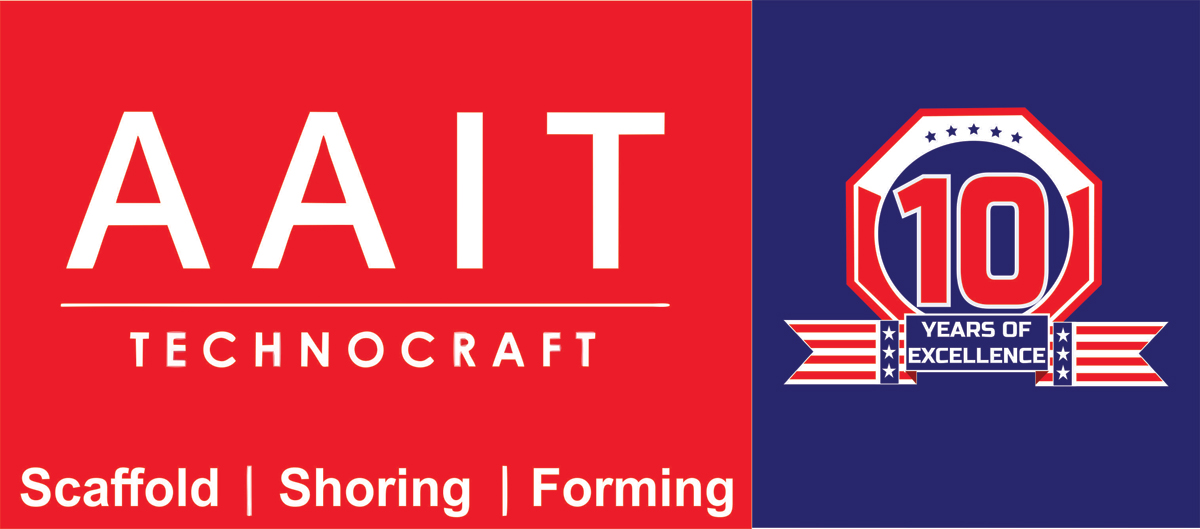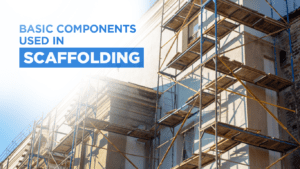Scaffolding is a temporary structure that facilitates support for the work crew, materials, and the entire man-made structure. It is widely used to access heights and areas that are otherwise hard to reach during maintenance, repair, and construction works.
Scaffolding accessories are secured together to erect a strong scaffolding structure. This structure is then leveraged to accomplish multiple tasks. Within the same structure, there are individual scaffolding components that meet specific requirements of heights, lengths, weights, and much more.
This article concentrates on those basic components used in scaffolding that leverage intricate tasks.
Basic Components Used In Scaffolding
1. Base Plate
These are also referred to as sole plates that bear the load of the entire structure. They are used to distribute weight and support the standards, or vertical scaffolding poles. Connecting the base plates to the scaffolding’s standards ensures a solid foundation.
Typical base jacks are made of steel and can be adjusted to various lengths. The modifications are made based on the required load capacity. Additionally, they are available in a variety of configurations, such as swivels that adjust to sloping terrain.
2. Standards
These are also referred to as uprights, verticals, or legs that are typical scaffold tubes. These tubes transfer the entire load to the ground as they are directly connected to the base plates. As the lengths of the standards are fixed, taller scaffolding requires that the pipes be connected so that the load is directed directly through the structure.
This is achieved using a “pin and socket” joint or a coupling pin, which twists to lock successive pipes together. Depending on the needs of the scaffold, standards are typically fabricated from galvanized steel.
3. Ledgers
These are also referred to as horizontal or runners that decide the horizontal length of the scaffold. These tubes are used to support the working platforms and determine the height at which deks are staged. They are placed between every standard and form a 3D structure that supports horizontal weights.
In some scaffolding systems, the same component serves as both the ledger and the transom; in these cases, both components are referred to as ledgers. The ledgers are made from structural steel and come with a galvanizing finish.
4. Adjustable Screw Jack
These are also referred to as leveling jacks or screw jacks that are designed to provide a level base for the scaffolding platform. They are also designed to fit with the caster with the bottom of the socket jack and are secured by a pin. There are various types of Adjustable Screw Jacks are designed and used in scaffolding systems.
The screw jack serves as the scaffold’s starting point. It is height-adjustable to compensate for uneven terrain so that a level scaffold is always attainable. Any scaffold base must always be positioned atop mudsills that have been demonstrated to be on solid ground.
They are made of structural steel and come with a galvanizing finish.
5. Adjustable Swivel Jack
It is a special type of adjustable screw jack that is employed on irregular ground. It is used as a starting base for a scaffold where the supporting surface of the scaffold is on a slope. They support the entire structure and bare weights of the structure including accessories and work crew.
Adjustable swivel jacks are made from high-strength structural steel and zinc-plated/ hot dip galvanized finish. This makes them corrosion-resistant and offers superior strength to the entire scaffolding structure.
6. Adjustable Hollow Base Jack
These are also known as adjustable screw jacks, scaffold jacks, leveling jacks, base jacks, jack bases, etc. It is used to compensate for differences in underground height for system scaffolding.
They can be used for various applications including light-duty to heavy-duty scaffolding works, shoring scaffolding systems, etc. These jacks can be employed for both- ringlock and cuplock systems to provide a strong and adjustable base.
They are made from structural steel and come with a hot dip galvanizing finish.
7. Adjustable U-Head Jack
U-Heads are intended to be utilized with Adjustable System Scaffolding. The primary function of a U-Head is to secure wooden beams in place. The U-Heads Jacks are of the highest quality made from structural steel and have a galvanizing finish that gives them a lustrous sheen.
8. Universal Davit Arm
The Universal Davit Arm is intended to support a Gin Wheel for lifting light loads or to act as a tie-off point for a retractable lifeline. It can be used with any type of system scaffolding including cuplock, ringlock, tube and clamp scaffolding, etc.
Half Couplers secure it to the system scaffold. In Construction Safety, the Davit Arm is also used as a scaffold hoist for fall protection. It is made of structural steel and comes with a galvanizing finish.
9. Universal Spigot
Universal Spigot is utilized in both the Ringlock and Cuplock systems. When required, the coupling pin comes with one set of fasteners for use on-site on both system verticals.
They are made from low alloy steel and come with a hot dip galvanizing finish.
10. Caster Wheels
By assembling the 12 Plug Caster from AAIT, you can move scaffolding components quickly. The Rubber/Polyurethane wheels are more suitable for traversing various terrain types. While the fitting portion of the Scaffold is made of low-alloy structural steel with high strength.
As a rolling base, the Scaffold caster is utilized. It enables the scaffold to be moved to different locations without being disassembled.
11. Toe Board
A toe board is a small vertical barrier typically attached to a raised floor or platform. The purpose of a toe board, which is typically between 4 and 12 inches tall, is to prevent objects or people from falling off or rolling off the side of a raised platform, such as preventing screwdrivers from dropped on the floor of elevated construction scaffolding from rolling off the side and onto people or objects below.
The toe boards are made from structural steel and come with a hot dip galvanizing finish.
12. Working Platform
Boards, also known as decks or battens, are the planks that make up the scaffold’s working platform. When working on scaffolding, workers stand on them and place their tools on top of them. In addition to providing support for standing, boards ensure the safety of workers working at great heights.
Material options for boards include wood, aluminum, aluminum frame with plywood board, and hot-dip galvanized steel. For protection against falls, guardrails, and toeboards can be added as accessories.
Want To Avail Best Scaffolding Accessories?
AAIT is a leading scaffolding accessories supplier in Houston. All the above-mentioned scaffolding accessories are ready at our warehouse in the USA. We comply with OSHA regulations and intent to provide safe and robust scaffolding components.
Get your free quotation today based on the scaffolding parts and functions you require.












 Download
Download
Comments are closed